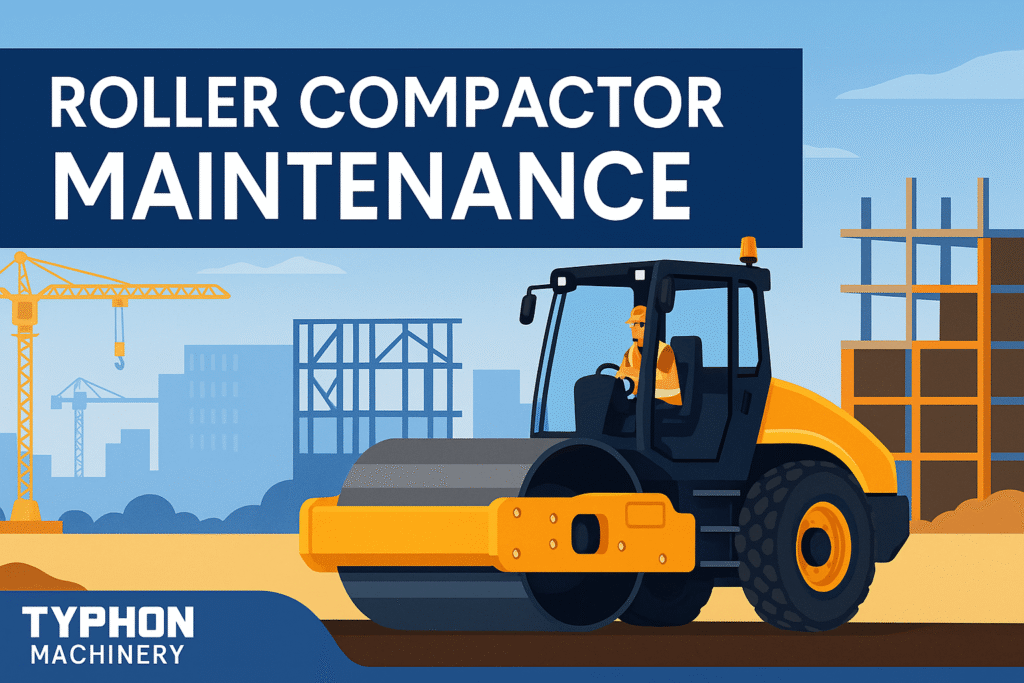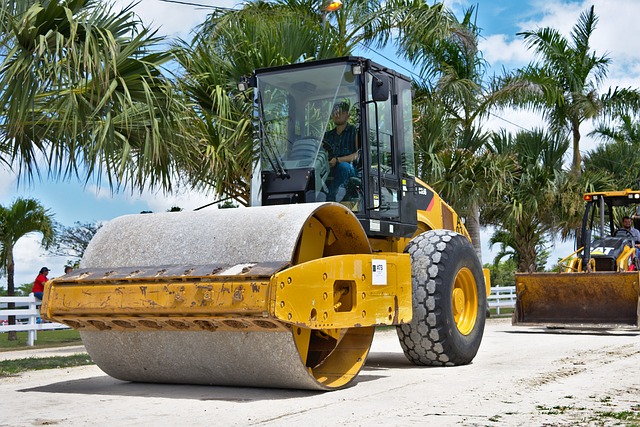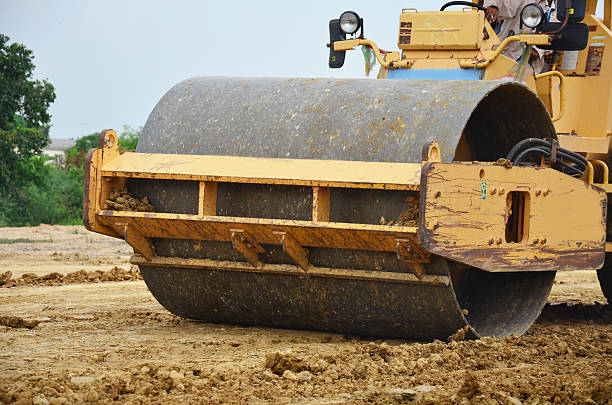Industrial Roller Compactor Maintenance
The effective performance and longevity of industrial compaction rollers are the primary concerns for heavy equipment operators, which depend on one crucial factor: regular maintenance.
The art of sustaining the roller compactor’s perfect state is not only increasing its life duration; it’s protecting the roller compactor properties, reducing expensive repair time, and ensuring the success of the project.
We have prepared this detailed compactor maintenance guide to help you understand the fundamentals and step-by-step procedures needed for the machine to operate at its best.
Why an Effective Maintenance Plan is a Must-Have?
The core of the success of any business is a clean and well-maintained fleet. The fact that regular maintenance has always a positive impact on a compactor’s efficiency, safety, and cost levels is undeniable and direct.
Simple routine checks can be disregarded which results in critical technical breakdowns; reduction in the compaction quality, and needless expenditures. The guide comes up with each stage of the process from everyday checks to the most technical troubleshooting, so you might be able to exploit your equipment more efficiently.
Knowing Your Roller Compactor: The Fundamental Components
To ensure total preparedness for the maintenance of the roller compactor, the most basic step is to know every part of the machine in sufficient detail. The operations of a roller compactor depend on:
The Drum System: This can be seen as the performance base of the machine. The heavy steel drum typically carries a vibration mechanism with eccentric weights and durable bearings, giving a driving effect that leads to the efficient compaction of the soil. Meanwhile, the water system provides the washing function which includes spray bars, nozzles, and the filters as the basic unit, thus, it also acts as the major component to prevent caking and it also gives a smooth surface finish.
The Hydraulic System: Just as the human body has the muscles as its power, so the hydraulic system of the machine has the same source of energy. The hydraulic unit is able to manage from a drum vibration to the machine being able to move. It employs pumps, motors, and valves, as well as having a fluid storage place to offer the exact control.
The Electrical System: On one hand the brain part of the machine which is the nervous system is responsible for the control of electronic inputs, sensors, and monitoring platform. On the other hand, it makes available the safety mechanisms that operate properly, supports operational controls, and enables the diagnostic data that is crucial to maintain the roller compactor in the best possible condition.
Key Insight: It is the right cooperation of the hydraulic drive, drum and electrical systems, which act together if the roller compactor becomes a prototype of good performance and durability of road works.
Daily Essentials: Your Pre-Operation Checklist for Peak Performance
For each shift, starting with a full daily check is the first and most important condition for space roller compactor preservation and for the early detection of failures leading to unexpected problems.
Fluid Level Management:
- Engine Oil: Make sure that the oil on the dipstick is within the recommended range by examining it. Adequate lubrication is a must for a good engine.
- Hydraulic Fluid: The issue of contaminated hydraulic fluid can create critical problems with the low or unclean level of it. You have to look at the liquid in the tank. If it is dirty, it needs to be cleaned, otherwise, it just needs the right level of the fluid. The last thing you do when checking the strength of the clamping oil is you verify that the machine is in a good condition after the oil servicing.
- Coolant: During the cold start it is the time to see whether the coolant is at the right level in the radiator or not so that the engine does not overheat.
System Visual Inspections & Cleaning:
- Drum Surface: Visual inspection of the drum for debris, damage, or wear that’s not even. The drum should be kept clean regularly so that there is no material build-up that could hinder proper compaction.
- Water Spray System: Be sure to check the condition of the spray bars, nozzles, and filters and clear if there are any blockages. Make sure to maintain blockage-free water distribution for a constant and even flow of water so that no material sticks to a degree where it becomes difficult to pick it up.
- Belts and Hoses: Always keep an eye out for visible signs of wear, cracking, or looseness.
- Air Filter: The unreadiness of the air filter can be determined by checking the indicator. The uncut air filter is a key factor in engine efficiency and life span. Be certain to clean or change it.
- Scraper Blades: The adjustment and the freedom from any damage are the characteristics of the correctly set and damage-free scraper blades.
- Overall Cleanliness: Regular and thorough cleaning of the whole machine, but particularly of the operator’s platform and controls, ensures the earliest recognition of potential problems.
Key Insight: By carrying
Remember that the purpose of the regular checking of the machine daily is to avoid breakdowns of your machine and keep it in operable condition thereby giving uninterrupted performance of the roller compactor. out simple, short checks and keeping the records in the appropriate condition, you achieve remarkably high equipment performance in the long run.
Proactive Care: Your Preventive Compactor Maintenance Guide
Perhaps the more fundamental or preventive form of care besides those everyday checks is the periodic maintenance schedule. This eventually goes a long way in determining the sustainability of the equipment.
Weekly Maintenance Tasks:
Drum and Scrapers: Check the drum for wear and give it a rinse to remove the contaminants to check how the wear is coming along. The condition of the scraper blade should also be kept in mind.
Hydraulic Connections: It is important to check all hydraulic connections for any leakage problems that will lead to the loss of oil and also to there is enough fluid in the system for the reliable performance of these machines.
Fault in the hydraulic system is only a common malfunction they reported, but of course, it is essential that consumers will check the technical condition of the system to prevent any accidents.
Water System: Always check for clogged nozzles and damage to the whole system as well.
Shock Mounts & Vibrators: Constantly look at the shock mounts as well as the vibration isolators to get a clear idea of any potential failure or damage.
Safety Features: It’s necessary to perform the emergency stop and the reverse alarm is monitored and also check your safety labels and instructions to see if you have a complete set of safety features.
Monthly and Quarterly Checks:
Belt Tensions: Belts are indeed subjected to wear and tear and so it is necessary to adjust as well as to carry out the repairs that the technician will count on.
Electrical Connections: We must probe deeply into all the different electrical connections and then take a look at the wired connections so as to find weak points and at the same time repair if necessary.
Compaction Monitoring System: Yes, do run the monitoring system if you have one in place.
Fluid Analysis (Quarterly): This analysis is far more extensive as it also includes oil checks for engine oil plus hydraulic fluid checks and coolant checks that may reveal an issue before it pops up to the surface.
Air Filtration System (Quarterly): Of course, do not overlook the importance of air filters being checked regularly and changed when necessary during servicing.
Bearings (Quarterly): Make sure that every single bearing is still properly greased and is not damaged.
Control Systems (Quarterly): Perform a check-up on all control systems and everything must work in their best effects.
Documentation is Key: A well-detailed record of all maintenance activities will help to track back the equipment history, locate repeating issues and improve your maintenance schedule.
Key Insight: A structurally preventative maintenance of compactor, having its regular weekly, monthly, and quarterly checks, is the best strategy for addressing unscheduled downtime and for preserving the roller compactor’s sustained performance.
Critical Focus Areas for Uninterrupted Operation
In fact, the regular maintenance of roller compactor equipment indeed requires that certain parts get much more attention than others.
Engine Care: Such are the magnificent standard of the compactor:
- Regularly change the oil;
- Then, do not forget to replace filter (oil, fuel, air);
- The engine should be checked (clean the fins and adjust the coolant levels) for a coolant system once a month.
Operational Best Practices: A skilled operator is the one who can adapt to the environmental conditions and always put personal safety first. For example, in case of a rise in temperature the most important is to make sure you are well- hydrated, take breaks and inspect the engine in order to prevent its overheating.
Make sure that you followed the cold start-up protocol, made a check of the viscosity of the fluid, and preserved your battery at all times when you were in a cold environment. Good communication and clear visibility are, therefore, prerequisites at all times.
Key Insight: Proper maintenance of the engine and the use of flexible operational practices play a decisive role in preventing failures and in the high performance of the roller compactor.
Troubleshooting Common Issues and Enhancing Performance
On top of that, it is a fact that common problems might still occur though, despite having maintenance done on the equipment as planned. It is very important to be aware of the causes of these issues and to be capable of solving them if they occur, as it ensures the continued performance of the roller compactor.
Uneven Compaction: This type of defect often occurs when the pallet knife scraper is worn or wrongly positioned. The only answer to this is to carry out regular checks and to adjust the equipment accordingly.
Reduced Compaction Force: You might face a problem with the hydraulic system, or the spring mounts are distressed. To solve the problem, you need to have the proper hydraulic fluid level and remember to change the spring mount in time.
Vibration System Malfunctions: Check if the eccentric bearings are the correct ones and they are properly lubricated. If you notice any strange patterns of vibration, go to the root of the problem at once.
Water System Issues: The nozzles might be clogged or the pumps might be damaged, which is the cause of the material buildup. Be punctual with your cleaning and filter change schedules.
The Future of Compactor Maintenance: Modern Technologies
Electrical preventive maintenance management systems are ground-breaking that is, the
way to look at machinery maintenance has totally transformed. These programs provide:
Real-time Monitoring: You would be warned about possible issues at once.
Automated Scheduling: It is the simplest way of doing maintenance planning.
Predictive Analytics: Data will make you understand how components behave and determine their wear or maintenance needs.
Detailed Reporting: The data help making informed decisions by tracking past records of accidents and their causes.
Key Insight: Through the implementation of newer-age digital instruments, equipment reliability and operational efficiency are hugely boosted. Moreover, roller compactor performance is further optimized.
Conclusion: Your Commitment to Excellence
Having and following a clear succession in the maintenance of your compactor is not only a series of duties to be performed but, first and foremost, the carrying out of a smart strategy for the preservation of your very expensive machinery.
Instead of leaving the work to the vacuum of nothingness, thus actively taking part in the reduction of the working time, avoiding the expenses of fuel and last but not least, ensuring safe and comfortable working conditions for the operators by the daily fluid checks, the comprehensive hydraulic system care, and the proper maintenance of the vibratory components.
A well-maintained compactor has a definite impact on the excellent compaction results of a road and the smooth finishing of a mat. Set these maintenance procedures as an essential part of your daily routine. Your dedication to the correct care of the machine will not only appreciate the roller compactor life but also ensure safety and the good results of the projects.
Frequently Asked Questions (FAQs)
Q1: What is the expected life of a roller compactor if the machine is always serviced?
A1: If the machines are maintained well and with care, the industrial roller compactor can work continuously for 8-12 years. Not only the above-mentioned factors but also the duration of life rely heavily on the intensity of use, the conditions of the operations, and the maintenance frequency. With regular and proper maintenance, units in good conditions, can even exceed the 12-year range.
Q2: When should the shock mounts on a vibratory roller compactor be replaced in relation to usage frequency?
A2: In principle, shock mounts should be checked every 500 hours of operation. As soon as they show signs of wear, cracks, or any signs of the rubber polymer material becoming brittle, replace them.
For the last 2000-2500 operating hours, —if the usage rate is quite high and the working conditions are unfavourable, the possibilities are that the proper vibratory function and roller compactor performance will be preserved respectively.
Q3: Is it safe to say that harsh weather only impacts compactor maintenance requirements?
A3: Yes, it does. Both extreme temperatures inevitably require changes to the maintenance guide of the compactor. In the case of cold weather, an unapproved hydraulic system may occur, thus, proper hydraulic system checks and diligent warm-up procedures should be done often.
On the other hand, high temperature requires an increased cooling system maintenance and a more frequent oil level to keep your heater as necessary. Thus, and above all, prevent overheating, which only impacts the performance of the roller compactor in an adverse manner, making it not only unsuitable but also an increased maintenance cost to the owner.
Q4: What are the main signs that the compactor drum needs urgent maintenance, and how urgent it should be?
A4: Visible signs are strange patterns of vibration, non-uniform and inconsistent compaction results, lack of the outward circular ending of the drum, presence of the stars’ junk and depletion of equipment, and the noise of fuel burning inefficiency.
Any one of these symptoms requires an immediate check and the suitable repair to avoid any further severe mechanical issue.
Q5: What is the relationship between suitable maintenance of a roller compactor and fuel consumption?
A5: Consistent maintenance is strongly related to fuel economy. A compacting machine that is in a good driving condition, with filters without dirt, full tanks of liquid, the engine running smoothly and the environment-friendly system of the hydraulic system set well, then the net result can be as good as 10-15% regarding the fuel efficiency level.
On the contrary, without the proper maintenance, there is a possibility that you will have to contend with up to 50% increased fuel consumption and, consequently, higher operating expenses.





